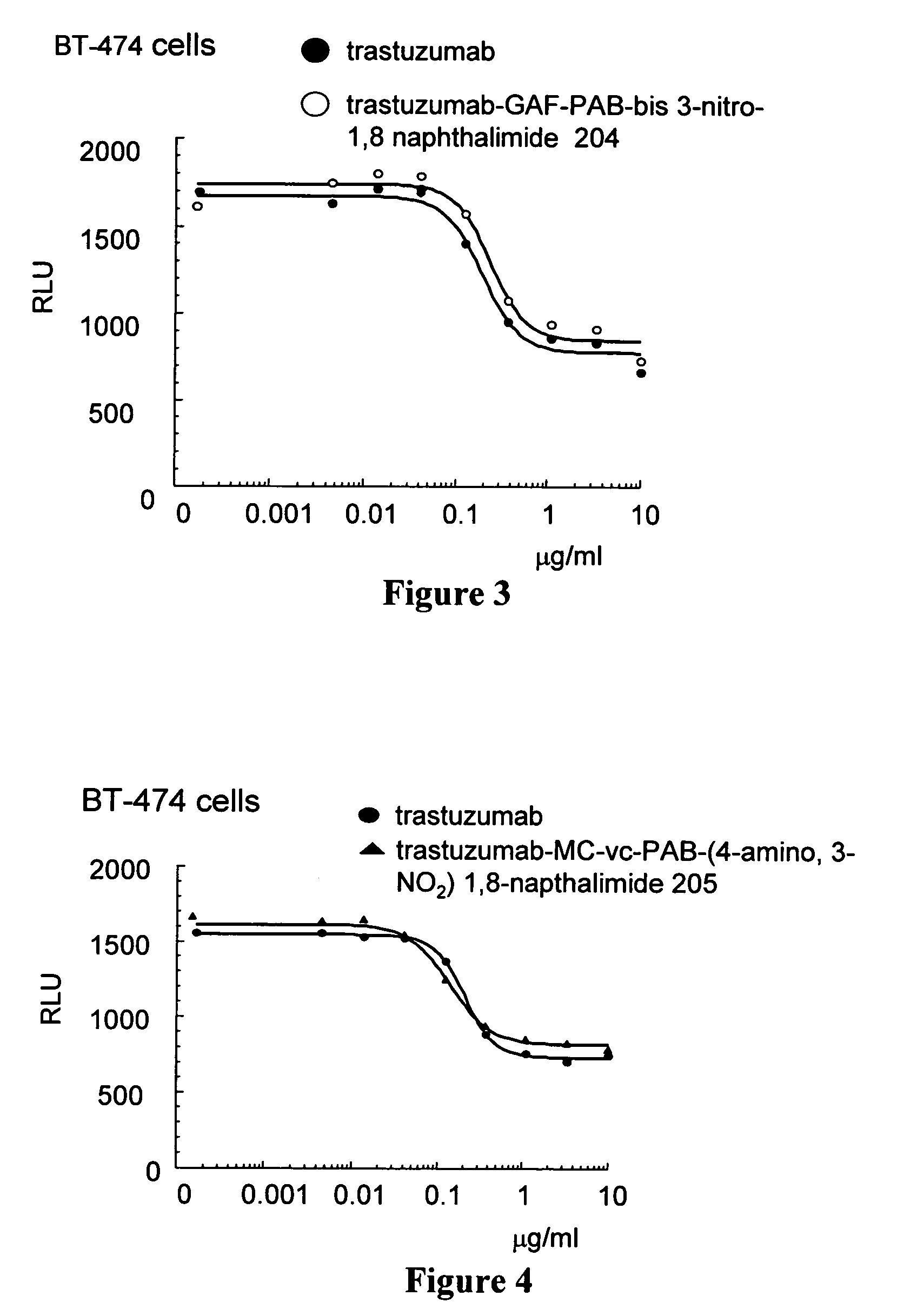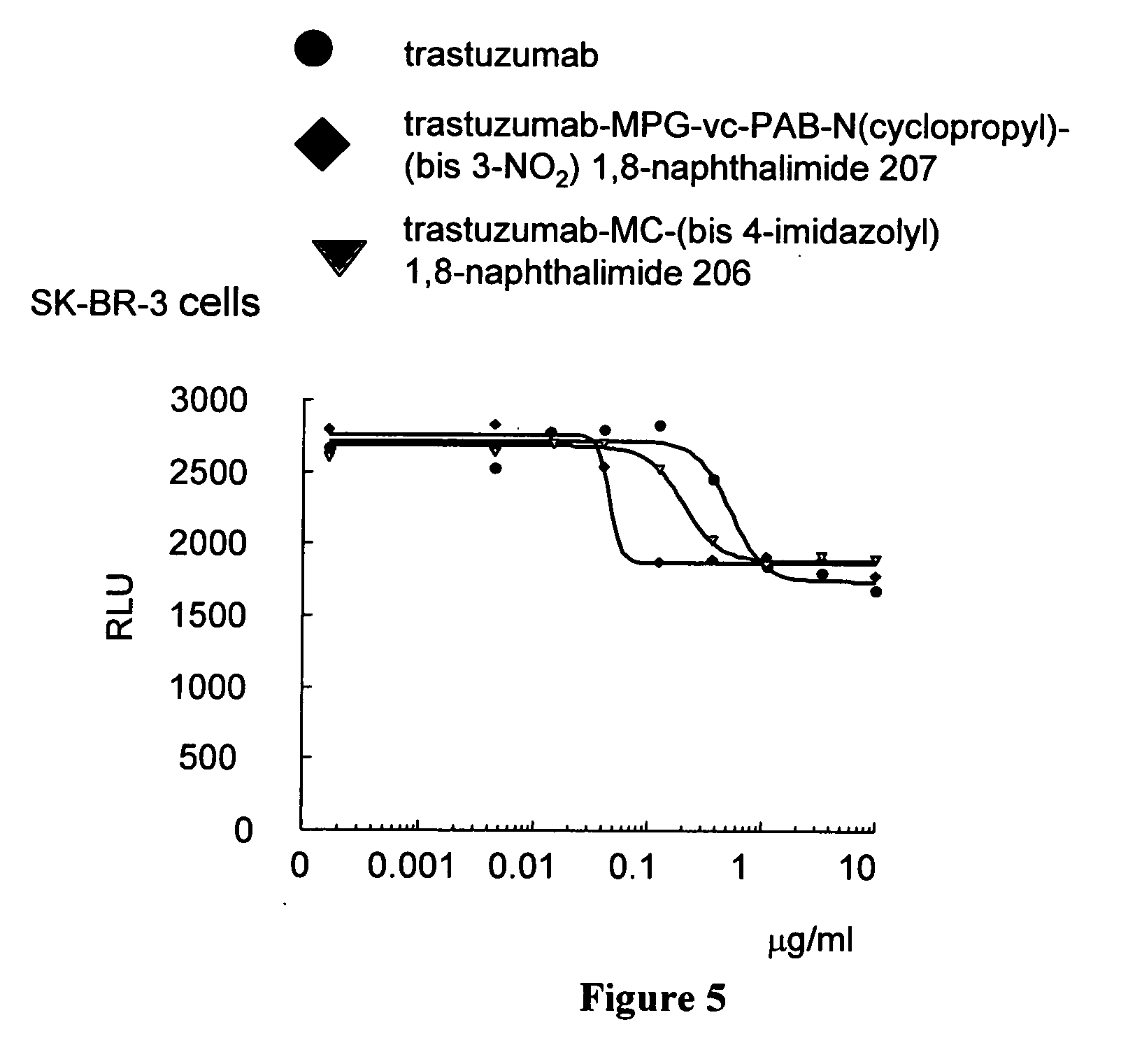Heterocyclic-substituted bis-1,8 naphthalimide compounds, antibody drug conjugates, and methods of use
a technology of naphthalimide and heterocyclic substitution, which is applied in the field of compounds with anticancer activity, can solve the problems of difficult or inefficient use, difficult intracellular target, and inability to minimize the redistribution of drugs, so as to kill or inhibit the proliferation of tumor cells, and the effect of killing or inhibiting the proliferation
- Summary
- Abstract
- Description
- Claims
- Application Information
AI Technical Summary
Benefits of technology
Problems solved by technology
Method used
Image
Examples
example 1
Synthesis of 4-morpholino-naphthoic anhydride 1
[0507]
[0508] A mixture of 4-bromo, naphthalic anhydride (0.21 gm, 0.74 mmoles), morpholine (0.61 ml, 0.70 mmoles), and 5 ml ethanol was heated for 4.5 hr at 160° C. in a 15 ml sealed tube. After cooling, the mixture was concentrated under vacuum, dissolved in 30 ml dichloromethane, washed with 1 M citric acid, dried and concentrated. The orange solid was triturated with toluene to an orange solid, 4-morpholino-1,8-naphthalic anhydride 1 (0.089 gm, 51% yield). LC / MS −283 MW. 1H NMR (300 MHz, CDCl3): δ 8.61 (1H, d, J=7.3 Hz), 8.55 (1H, d, J=8.4 Hz), 8.48 (1H, d, J=8.5 Hz), 7.75 (1H, t, J=8.1 Hz); 7.27 (1H, dd, J=8.1 Hz); 4.31 (4H, m); 3.31 (4H, m).
example 2
Synthesis of 1,3-bis glycyl-1,3diaminopropane 2
[0509]
[0510] Carbonyl diimidazole (CDI, 0.71 gm, 4.40 mmoles) was added to a mixture of 10 ml dichloromethane and BOC-glycine (0.73 gm, 4.19 mmoles) at 0° C. under nitrogen. After 2 hr at 0° C., 1,3propanediamine (0.18 ml, 2.0 mmoles) was added and the mixture was warmed to room temperature and stirred overnight. The mixture was diluted with dichloromethane and extracted with sat. NaHCO3. The aqueous phase was extracted 2× with dichloromethane. The combined organic phases were washed with sat. NaCl, dried over MgSO4, and concentrated under vacuum to give the 1,3bis BOC glycyl-1,3diaminopropane intermediate as a white sticky solid. 1H NMR (300 MHz, CDCl3): δ 6.76 (2H, s, br); 5.30 (2H, s, br); 3.77 (4H, d, J=5.7 Hz); 3.31 (4H, m); 1.66 (2H, m); 1.4 (9H, m). This intermediate was taken up with 16 ml 1M HCl in AcOH and stirred under nitrogen at room temperature for 2 hours. The mixture was concentrated under vacuum to a white solid which ...
example 3
Synthesis of N1,N3-bis(2-aminoethyl)malonamide 3
[0511]
[0512] A solution of malonyl chloride (0.5 ml, 5.0 mmoles) in 4 ml dichloromethane under nitrogen was stirred at 0° C., then added dropwise over 30 minutes to a stirred solution of mono BOC-1,2-diaminoethane (1.6 ml, 10.0 mmoles) and triethylamine (1.67 ml, 12 mmoles) in 5 ml dichloromethane at 0° C. The solution was allowed to warm to room temperature and stir overnight. The cloudy orange mixture was diluted with 90 ml dichloromethane, washed with 30 ml each of 2N HCl, sat NaHCO3, and sat. NaCl, then dried over MgSO4 and concentrated under vacuum to give the bis BOC intermediate as a sticky orange solid 1H NMR (300 MHz, CDCl3): δ 7.27 (2H, m); 5.01 (4H, s, br); 3.38 (4H, m); 3.28 (4H, m); 3.16 (s, 2H). The BOC groups were removed to give N1,N3-bis(2-aminoethyl)malonamide 3.
PUM
| Property | Measurement | Unit |
|---|---|---|
| Dimensionless property | aaaaa | aaaaa |
| Digital information | aaaaa | aaaaa |
| Volume | aaaaa | aaaaa |
Abstract
Description
Claims
Application Information
 Login to View More
Login to View More - R&D
- Intellectual Property
- Life Sciences
- Materials
- Tech Scout
- Unparalleled Data Quality
- Higher Quality Content
- 60% Fewer Hallucinations
Browse by: Latest US Patents, China's latest patents, Technical Efficacy Thesaurus, Application Domain, Technology Topic, Popular Technical Reports.
© 2025 PatSnap. All rights reserved.Legal|Privacy policy|Modern Slavery Act Transparency Statement|Sitemap|About US| Contact US: help@patsnap.com



